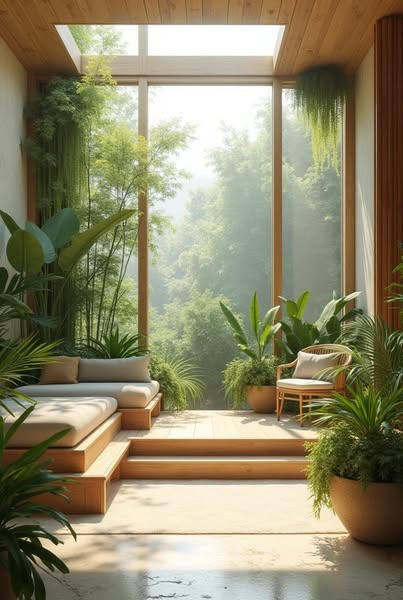
About Course
🧱 Course Title: Sustainable Interior Design: Eco-Friendly Materials and Practices
Code: 6001-DE
Duration: 6 Weeks
🔰 Introduction
This course is designed to equip interior designers, architects, and sustainability enthusiasts with a solid foundation in sustainable interior design practices. By focusing on eco-friendly materials, energy-efficient systems, and cultural sensitivity, participants will learn to create spaces that are not only beautiful and functional but also environmentally responsible.
📘 Course Description
Sustainable interior design is no longer a trend—it’s a necessity. This course explores how to reduce environmental impact through smart design strategies, material selection, and compliance with international sustainability standards. Participants will analyze real-world case studies, evaluate different types of sustainable materials, and complete a practical project integrating all the learned principles.
Through a project-based and learner-centered approach, the course blends theory with hands-on design experience, encouraging participants to create environmentally and socially conscious interior environments.
🎯 Learning Objectives
By the end of this course, learners will be able to:
-
Understand and apply the core principles of sustainable design.
-
Identify and source sustainable, recyclable, and renewable materials.
-
Incorporate energy-saving solutions into design layouts.
-
Align projects with international standards such as LEED and WELL.
-
Consider social and cultural dimensions in sustainable design.
-
Design and present a fully integrated sustainable interior project.
Understanding:
-
Gain proficiency in sustainable material selection.
-
Create efficient and healthy interior spaces using energy-saving strategies.
-
Understand the requirements of LEED, WELL, and other certifications.
-
Develop and present a full-scale sustainable interior design concept.
-
Build a portfolio-ready project that demonstrates their skills and environmental values.
🧱 Course Modules – Weekly Breakdown
📅 Week 1: Introduction to Sustainable Interior Design
-
What is sustainability in the context of interiors?
-
The environmental impact of interior spaces
-
Core principles: efficiency, durability, life-cycle thinking
-
Integrating sustainability into the design process
-
Examples of successful sustainable interiors
📅 Week 2: Sustainable Materials & Resource Selection
-
Types of sustainable materials: rapidly renewable, salvaged, biodegradable
-
Bamboo, cork, recycled glass, FSC-certified wood
-
Evaluating material certifications (e.g., GreenGuard, Cradle to Cradle)
-
Case study: comparing conventional vs. sustainable materials
-
Practical: sustainable materials research log
📅 Week 3: Energy Efficiency in Interior Environments
-
Passive design strategies: orientation, ventilation, insulation
-
Lighting design: maximizing daylighting and LEDs
-
Energy-efficient HVAC systems and controls
-
Smart technologies in sustainable interiors
-
Tool: Energy use audit and improvement checklist
📅 Week 4: Green Certifications and Environmental Standards
-
Overview of LEED, WELL, BREEAM certifications
-
Design guidelines for healthy and efficient interiors
-
Required documentation and credit categories
-
Incorporating certification into design planning
-
Assignment: mock certification checklist for a sample project
📅 Week 5: Social, Cultural, and Ethical Dimensions
-
Local sourcing and craftsmanship: reducing embodied carbon
-
Designing for accessibility and inclusivity
-
Cultural sensitivity in design aesthetics
-
How sustainable design supports communities
-
Workshop: designing with community values in mind
📅 Week 6: Capstone Project – Sustainable Design Proposal
-
Final Project: Create a full interior design proposal applying all sustainability principles
-
Sections: concept board, material selection, lighting and energy strategy, floor plan, LEED points outline
-
Presentation: verbal walkthrough + digital board
-
Peer and instructor critique and feedback
-
Course wrap-up and portfolio guidance
-
🎓 Learning Outcomes
By the end of this course, participants will be able to:
1. Apply Sustainable Design Principles
-
Demonstrate a clear understanding of the core principles of sustainable interior design including resource efficiency, durability, recyclability, and lifecycle thinking.
-
Integrate sustainability into all phases of the design process—from concept to execution.
2. Identify and Select Eco-Friendly Materials
-
Evaluate and compare materials based on environmental impact, renewability, embodied energy, and certifications (e.g., FSC, GreenGuard, Cradle to Cradle).
-
Justify material choices for various interior components such as flooring, finishes, and furnishings based on performance and sustainability criteria.
3. Enhance Energy Efficiency in Interior Environments
-
Design interiors with passive energy strategies such as natural lighting and cross-ventilation.
-
Integrate energy-saving systems (e.g., LED lighting, efficient HVAC) into interior layouts to reduce operational carbon footprint.
4. Align Designs with Global Sustainability Standards
-
Interpret and apply relevant green building standards such as LEED, WELL, and BREEAM in interior design projects.
-
Prepare basic documentation and strategies to meet certification requirements.
5. Address Social and Cultural Sustainability
-
Incorporate inclusive, accessible, and culturally sensitive design elements.
-
Promote local materials, crafts, and labor to support sustainable economies and reduce environmental impact.
6. Develop and Present a Sustainable Interior Project
-
Complete a capstone project that includes a sustainable material palette, lighting strategy, energy efficiency plan, and LEED-compliant layout.
-
Present the project visually and verbally using professional standards suitable for client or stakeholder presentation.
7. Build a Sustainability-Focused Design Portfolio
-
Create a compelling design case study demonstrating sustainable strategies.
-
Use this work as part of a professional interior design portfolio or for accreditation support.
-
Course Content
🧱 Sustainable Interior Design: Eco-Friendly Materials and Practices
Student Ratings & Reviews



